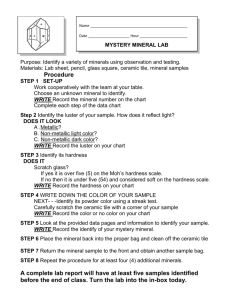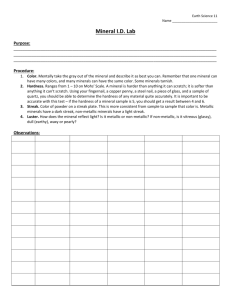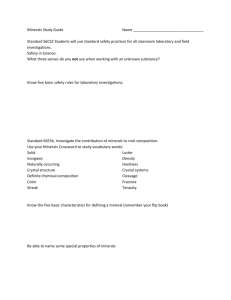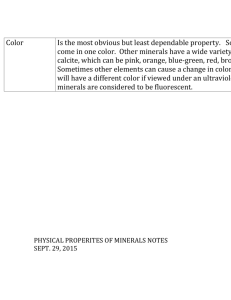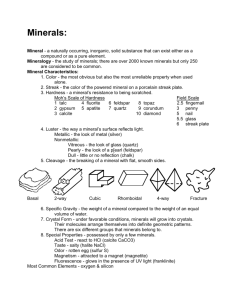Mineral Identification
advertisement
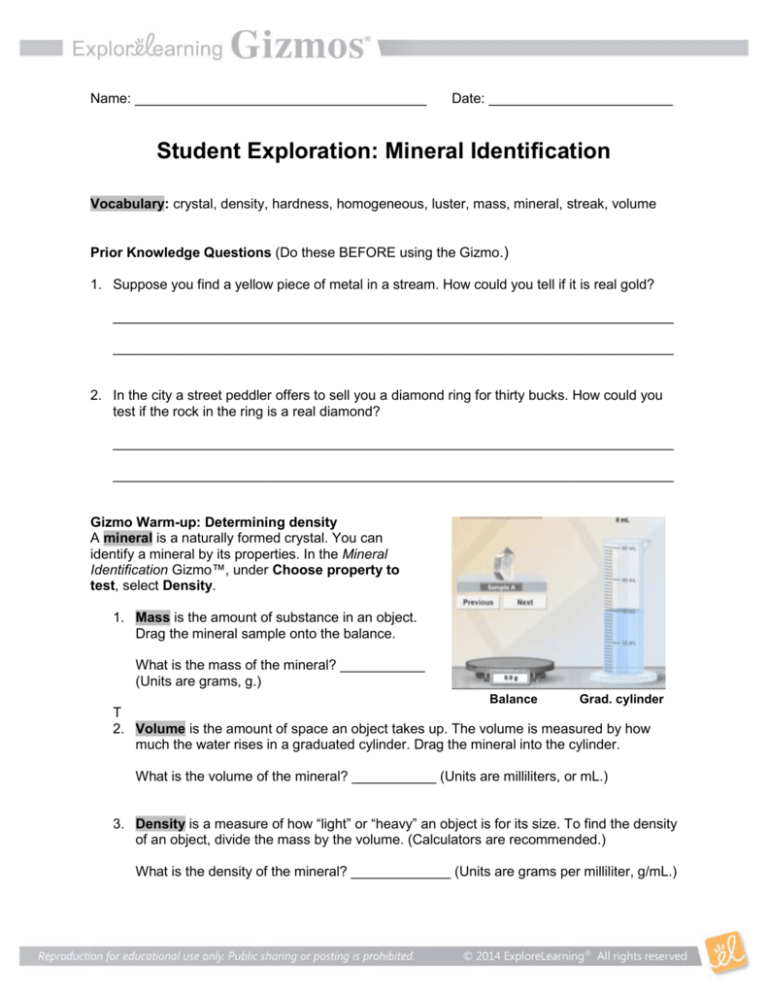
Name: ______________________________________ Date: ________________________ Student Exploration: Mineral Identification Vocabulary: crystal, density, hardness, homogeneous, luster, mass, mineral, streak, volume Prior Knowledge Questions (Do these BEFORE using the Gizmo.) 1. Suppose you find a yellow piece of metal in a stream. How could you tell if it is real gold? _________________________________________________________________________ _________________________________________________________________________ 2. In the city a street peddler offers to sell you a diamond ring for thirty bucks. How could you test if the rock in the ring is a real diamond? _________________________________________________________________________ _________________________________________________________________________ Gizmo Warm-up: Determining density A mineral is a naturally formed crystal. You can identify a mineral by its properties. In the Mineral Identification Gizmo™, under Choose property to test, select Density. 1. Mass is the amount of substance in an object. Drag the mineral sample onto the balance. What is the mass of the mineral? ___________ (Units are grams, g.) Balance Grad. cylinder T 2. Volume is the amount of space an object takes up. The volume is measured by how much the water rises in a graduated cylinder. Drag the mineral into the cylinder. What is the volume of the mineral? ___________ (Units are milliliters, or mL.) 3. Density is a measure of how “light” or “heavy” an object is for its size. To find the density of an object, divide the mass by the volume. (Calculators are recommended.) What is the density of the mineral? _____________ (Units are grams per milliliter, g/mL.) Get the Gizmo ready: Activity A: Under Property, select Appearance. Mineral properties Check that Sample A is on the screen. (If not, press Previous until sample A is there.) Question: What properties allow us to identify minerals? 1. Observe: Minerals are made of atoms in a repeating pattern and often form crystals. The shapes of crystals can help identify the mineral. Luster is the way the mineral’s surface reflects light. There are many ways to describe luster, four examples are shown. Color can sometimes be a useful way to identify a mineral, but it is not always reliable. A. Describe the crystal shape of Sample A: __________________________________ B. Describe its color and luster: ____________________________________________ 2. Calculate: Select the Density test. What is the density of Sample A? __________________ 3. Measure: Select the Hardness test. Hardness is a measure of how easily a mineral can be scratched. It is measured on a scale of 1 to 10 called Mohs scale. If a mineral scratches a fingernail (hardness 2.5) but not a penny (3.5), its hardness is about 3. A. Drag the mineral sample across each test object. Which objects are scratched? ___________________________________________________________________ B. What is the estimated hardness of the mineral? _____________________________ 4. Observe: Select the Streak test. The streak is the color of a material’s powder. You can observe the streak by rubbing the mineral across a tile called a “streak plate.” Drag the mineral sample across the streak plate. What color is the streak? ______________ (Note: In some cases the streak is colorless and cannot be seen.) 5. Observe: Select the Acid test. Some minerals cause hydrochloric acid to bubble and fizz. Drag the eyedropper of acid over to the mineral. Does the acid fizz? ___________________ 6. Identify: Now it is time to identify the mineral. Look at your Mineral Key. Find a mineral that has properties that match Sample A. Type the name under Mineral name in the Gizmo and press Submit. It may take several guesses to get it right. What mineral is Sample A? __________________________________________________ Activity B: Get the Gizmo ready: Identifying minerals Click Next so that Sample B is showing. Goal: Use a key to identify minerals. 1. Collect data: Use the Gizmo to collect data about minerals B through F. Fill in the data table. Sample Crystal shape Color/ Luster Density Hardness Streak Fizzes in acid? B C D E F 2. Identify: Use the Mineral Key to identify minerals B through F. Submit your answers in the Gizmo. (Use the Previous and Next buttons to switch samples.) Record your results below: Sample Mineral name (first try) Mineral name (actual) Correct on first try? B C D E F 3. On your own: Continue to practice identifying minerals. (There are 26 samples in the Gizmo: A through Z.) Record your findings in your notebook or on separate sheets of paper. 4. Form a conclusion: Which properties were most useful for identifying minerals? Why? _________________________________________________________________________ _________________________________________________________________________ Mineral Key Use the following steps to identify a mineral: 1. Decide if the mineral is metallic or non-metallic based on its luster and streak. 2. If the mineral is non-metallic, decide if it is light or dark in color. 3. Find a mineral in the list with the same density and hardness as your sample. 4. Check that the other properties—crystal shape, color, streak, acid reaction—match. Metallic minerals (luster of each mineral ranges from metallic to dull) Mineral Crystal shape Color Density Hardness Streak Fizzes in acid? Galena (lead ore) Cubic/ irregular Gray 7.5 g/mL 3 Dark gray No Gold Irregular Golden yellow 19.3 g/mL 3 Yellow No Graphite (pencil lead) Irregular Dark gray 2.2 g/mL 2 Gray No Hematite (iron ore) Irregular Red-brown to black 5.3 g/mL 6 Red-brown No Magnetite (iron ore) Irregular Black 5.2 g/mL 6 Black No Malachite (copper ore) Irregular Dark green 4.0 g/mL 4 Light green No Pyrite (fool’s gold) Cubic/ irregular Greenish yellow 5.0 g/mL 6 Dark green No Silver Irregular Silver gray 10.5 g/mL 3 Gray No Non-metallic minerals, mostly dark in color (glassy, pearly or dull luster) Mineral Crystal shape Color/ luster Density Hardness Streak Fizzes in acid? Corundum (Ruby) Hexagon/ irregular Dark red, glassy/dull 4.0 g/mL 9 Colorless No Garnet Ball shape Dark red, glassy/dull 4.0 g/mL 7 Colorless No Mica Flat sheets Black/white, glassy 3.0 g/mL 3 Colorless No Topaz Hexagon/ irregular Variable, glassy 3.5 g/mL 8 Colorless No Non-metallic minerals, mostly light in color (glassy, pearly or dull luster) Mineral Crystal shape Color/ luster Density Hardness Streak Fizzes in acid? Calcite Rhombus/ irregular Variable, glassy 2.7 g/mL 3 Colorless Yes Diamond Pyramid/ irregular Variable, glassy 3.5 g/mL 10 Colorless No Dolomite Irregular Variable, pearly/dull 2.9 g/mL 4 Colorless Yes Feldspar Rectangle/ irregular Pink/white, pearly 2.6 g/mL 6 Colorless No Fluorite Pyramid/ irregular Variable, glassy 3.2 g/mL 4 Colorless No Gypsum Rectangle/ irregular Variable, pearly/dull 2.3 g/mL 2 White No Halite Cubic Variable, glassy 2.2 g/mL 3 Colorless No Kaolinite Irregular Variable, dull 2.6 g/mL 2 White No Quartz Hexagon/ irregular Variable, glassy 2.6 g/mL 7 Colorless No Sulfur Irregular Yellow, waxy 2.1 g/mL 2 Yellow No Talc Irregular Variable, pearly 2.7 g/mL 1 White No
